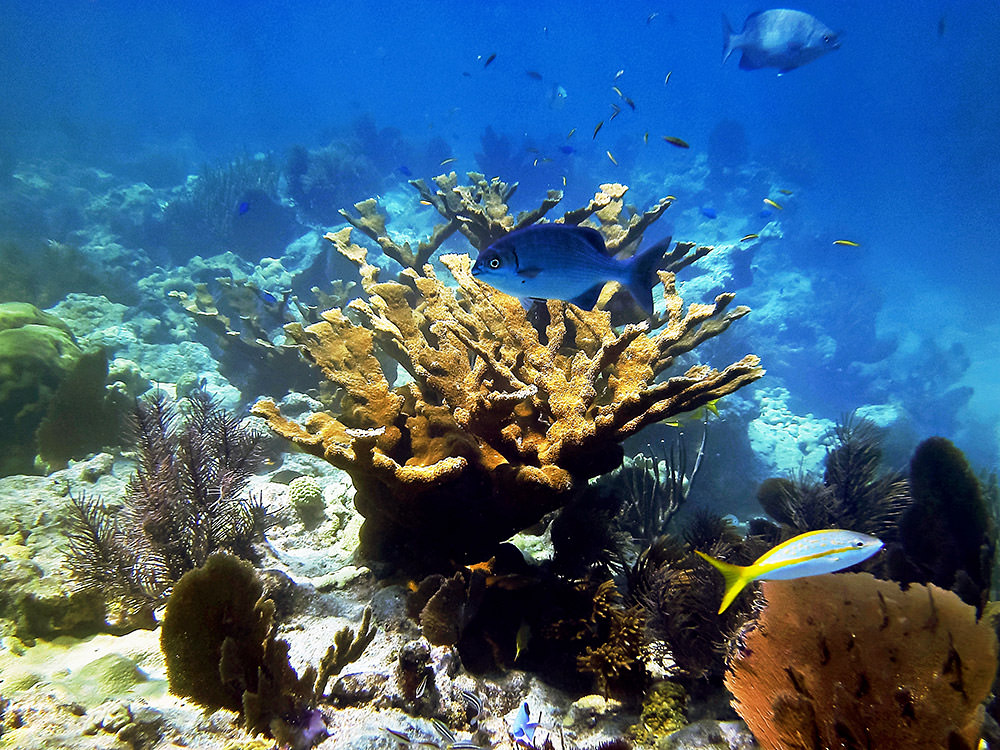Habitats
Florida Keys National Marine Sanctuary encompasses five distinct regions that are environmentally and geologically unique. Together, these regions form the framework for the sanctuary's diverse terrestrial and marine habitats.
- Florida Bay is a system of shallow basins separated by interconnected mud banks or shoals. Seasonal variations in temperature and salinity are common. Tides carry nutrient-rich water and sediments to the Florida Reef Tract.
- The southwest continental shelf, extending from the Florida Keys island chain to the Straits of Florida, includes extensive seagrass beds and live bottom habitats supporting fish, sea turtles, corals, sponges, and other invertebrates.
- The Florida Reef Tract is located on the continental shelf and is the most extensive living coral reef ecosystem in North America.
- The Straits of Florida parallel the Florida Keys and the Florida Keys Reef Tract. The warm, clear, low-nutrient waters of the Florida Current create the stable conditions that make coral reef development possible at this more northerly latitude. The Florida Current brings larvae spawned elsewhere in the Caribbean Basin and Dry Tortugas to the Florida Keys.
- The Florida Keys extend over 220 miles with 1,700 islands in five distinct areas: the Upper, Middle, and Lower Keys, the Marquesas, and the Dry Tortugas.
Coral reefs

The skeletons of corals and other marine life become cemented together over time to form a rigid, wave-resistant living structure. Coral reefs support fisheries, tourism, and recreation, and provide vital coastal shoreline protection. In 2016, stony corals covered only 6.5 percent and soft corals 13.3 percent of reefs within Florida Keys National Marine Sanctuary. Corals face a multitude of threats including intensifying storms, disease, climate change, ocean acidification, pollution, vessel groundings, and other human impacts. Restoration and relieving stress are the keys to the future of the Florida Reef Tract.
NOAA and partners have launched an unprecedented effort to restore seven ecologically and culturally significant coral reefs within Florida Keys National Marine Sanctuary.
Learn more about Mission: Iconic Reefs at www.fisheries.noaa.gov/iconic-reefs
Hardbottom
Shallow hardbottom communities are found throughout nearshore environments of the Florida Keys on both the ocean and bay side. They support dozens of species of sponges, sea fans and branching gorgonians, stony corals, and macroalgae. Hardbottom areas provide critical nurseries for many commercially important invertebrates and fishes. These habitats can be destroyed easily through siltation or placement of fill. They are particularly sensitive to water quality changes associated with thermal stress, salinity, and harmful algal blooms.
Beaches, sandflats, mudflats, and tidal flats
While these areas may seem relatively barren, the densities of organisms can reach tens of thousands per square meter. Submerged sandflats are habitats for commercially important fishes. Mudflats are feeding grounds for many shorebirds and invertebrates.Tidal flats provide essential foraging habitat for wading and shorebirds. Beach and associated dunes afford nesting, foraging, and loafing habitat for a variety of shorebirds, wading birds, and seabirds. These areas are highly susceptible to sea level rise.
Seagrass
The Florida Keys ecosystem includes one of the world's largest seagrass beds. Seagrass stabilizes the sea bottom, helps to maintain water clarity, and provides critical habitat for fish and invertebrates and foraging areas for turtles, manatees, parrotfish, and sea urchins. An array of terrestrial wildlife depends upon seagrass communities for their diet. Seagrass beds have declined due to water quality degradation and through the direct loss of habitat related to dredging, coastal development, and boating impacts. Increased sea surface temperatures, reduced freshwater inputs, elevated salinity, and increased nutrients contribute to die-offs.
Mangroves
Red mangrove trees fringe shorelines, while the black and white mangrove species are found farther inland. Mangrove wetlands filter runoff and provide a protective barrier that diminishes the intensity of storm surges. Mangroves provide protected nursery areas for commercially- and recreationally-valuable fish, as well as crustaceans, shellfish, and other invertebrates. Mangrove tree canopies serve as roosting and nesting areas for many resident and migrating bird species. Since the 1940s, when dredge and fill operations began in the Florida Keys, mangrove forests have suffered significant losses. Today, stronger protective measures are in place. However, mangroves are susceptible to weather events as evident from impacts from Hurricane Irma.

